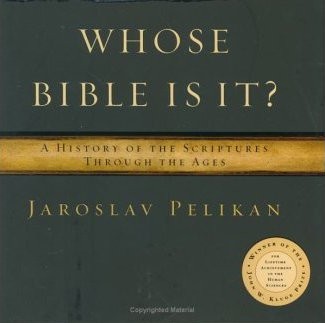 Most books about the Bible are principally concerned with how it came to be and what it meant in its historical context. But ̵’; as readers of Jaroslav Pelikan’s ”Whose Bible Is It?” will find ̵’; that is really only the beginning of the Bible’s story. Even before the last chapters of the Hebrew Bible itself had been written‚ an ancient school of biblical interpreters had come upon the scene ̵’; the earliest of them going back to the third century B.C. or so ̵’; and they changed forever the way the Bible would be read. They (mostly anonymous) were decidedly not interested in what the stories‚ laws or prophecies had meant in their original context. They believed the Bible was a divinely given guidebook‚ eternally relevant. What interested them was what it had to teach people in their own day‚ and often this meant ignoring history and digging deeper‚ trying to find some hidden lesson in the Bible’s words. Sometimes this process involved a great deal of imagination ̵’; reinterpreting a common word or phrase to mean something quite different from its usual meaning‚ or even ”deducing” the existence of conversations or whole episodes unreported in the Bible itself. They claimed it was full of teachings only hinted at in its actual words.
Most books about the Bible are principally concerned with how it came to be and what it meant in its historical context. But ̵’; as readers of Jaroslav Pelikan’s ”Whose Bible Is It?” will find ̵’; that is really only the beginning of the Bible’s story. Even before the last chapters of the Hebrew Bible itself had been written‚ an ancient school of biblical interpreters had come upon the scene ̵’; the earliest of them going back to the third century B.C. or so ̵’; and they changed forever the way the Bible would be read. They (mostly anonymous) were decidedly not interested in what the stories‚ laws or prophecies had meant in their original context. They believed the Bible was a divinely given guidebook‚ eternally relevant. What interested them was what it had to teach people in their own day‚ and often this meant ignoring history and digging deeper‚ trying to find some hidden lesson in the Bible’s words. Sometimes this process involved a great deal of imagination ̵’; reinterpreting a common word or phrase to mean something quite different from its usual meaning‚ or even ”deducing” the existence of conversations or whole episodes unreported in the Bible itself. They claimed it was full of teachings only hinted at in its actual words.
The ideas of these interpreters‚ which survive in a host of early Jewish and Christian writings‚ were extraordinarily influential. After all‚ ordinary people in those days did not just pick up a Bible and start trying to understand it on their own; copies of Scripture were scarce‚ and in any case‚ the teachings of these wise commentators were soon considered authoritative. What they said the Bible meant simply became what it meant. Their approach‚ and much of their not inconsiderable body of interpretation‚ reached ordinary folk in a variety of ways ̵’; in sermons and hymns‚ school lessons and memorized dogmas‚ sculptures and stained-glass windows. It was passed on to Jews from late antiquity through the Middle Ages in Talmud and midrash‚ and became among Christians the basis of Scripture’s multifaceted ”spiritual sense.”
Although the religious establishments of both religions continued to sponsor these traditional approaches throughout the Middle Ages and beyond‚ individual scholars eventually came to question them. Was Scripture really full of hidden teachings or subtle allusions to future events? What if what the Bible seemed to be saying was all that it ever meant to say? Such questions were asked‚ particularly among Jews‚ as early as the 11th and 12th centuries. But a veritable revolution in biblical scholarship began toward the end of the Renaissance among a group of Christian Bible scholars in Western Europe. On the model of leading classicists‚ who sought to revive a knowledge of the language and literature of ancient Greece and Rome‚ these scholars began to learn Hebrew and Greek and to consider the Bible from a similarly philological perspective. It took less than a century for them to cast off much of the early interpretive tradition‚ and to proceed from timidly questioning ancient teachings about the text to the flat-out assertion that such teachings were mistaken.
Much of the impulse for this activity was channeled into the nascent Protestant churches. Their revolt against Rome was not only against what they argued was corruption; as much as anything else‚ they did not like the traditional Catholic reading of the Bible; to them it did not make sense anymore. So the Protestant denominations became the leading sponsors of a new movement to read the Bible with unblinkered eyes‚ rejecting all past traditions about what it meant (though this turned out to be harder than they thought) and reckoning only with the words of Scripture themselves. Unwittingly‚ they thus helped create modern biblical scholarship‚ which has ended up casting doubt on the veracity of much of Scripture and has highlighted various contradictions‚ conflicting sources and other human touches that have undermined its traditional authority. The result is what some modern scholars have called a crisis in biblical theology‚ one that the present generation of scholars has hardly managed to resolve.
All this is the raw material for Pelikan’s book. The answer he offers to his title’s question embraces all the twists and turns of the Bible’s history. Scripture belongs to the Jews‚ but also to the Christians‚ to Catholics but also to Protestants. It is the central text of traditional faith‚ but also the Bible of the skeptical modern scholar. Pelikan‚ an eminent Yale historian‚ is a veteran of the Bible wars ̵’; the author of a five-volume study of the history of Christian doctrine‚ as well as of an astonishing number of monographs on church history‚ individual church figures and the Bible itself.
His present work begins with a history of how the Bible came to be‚ stressing the role of the spoken word in its creation. It then moves to a quick tour of the Hebrew Bible’s contents and its translation into Greek (a fateful step that allowed it to spread‚ under the aegis of Christianity‚ throughout the Greek-speaking world); the formation of the New Testament and the transformation of the Bible in medieval Christianity; and the Renaissance‚ concluding with the great sea change in attitudes toward the biblical text since that time. Pelikan’s last chapter ̵’; the best in the book ̵’; consists of reflections on the Bible in our own day‚ its persistent strangeness despite everything we now know‚ and its ability to draw us into its world.
Pelikan has an engaging style and a host of telling quotations‚ from Milton to Oscar Wilde to his own Aunt Vanda. There is nothing pompous here; the book wears its erudition well. Still‚ it leaves me‚ I must confess‚ somewhat disappointed. Throughout Pelikan seems to be holding back‚ telling less than he knows‚ so the book has a kind of glossy‚ airbrushed quality. The trouble is not that it tries to cover too much ̵’; though it does range over more than 3‚000 years of history ̵’; but that‚ in so doing‚ it seems to forgo much of its potential sharpness or focus. The Bible contains some of the most startling sentences ever written‚ and some of the most influential. It has also been the most disputed of books‚ the battleground of great wars of faith; it has provided justification for some of the most sublime‚ and some of the most dastardly‚ beliefs and actions. No student of religion can doubt that Pelikan knows all this in detail. Yet‚ surprisingly‚ his book rarely gets down to the nitty-gritty. Like a tourist in a hurry‚ it seems ambitious‚ sometimes‚ merely to be able to say it’s been there. Still‚ even if it could have lingered longer on the details‚ there is no denying that this is an excellent overview‚ one that will introduce readers to everything that happened to the Bible since it was written.
A review by James Kugel. Read more here www.nytimes.com
Buy this book here Whose Bible Is It?: A Short History of the Scriptures
